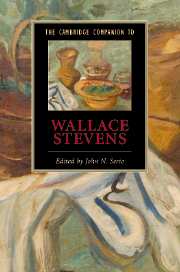Book contents
- Frontmatter
- Introduction
- 1 Wallace Stevens: A Likeness
- 2 Stevens and Harmonium
- 3 Stevens in the 1930s
- 4 Stevens and the supreme fiction
- 5 Stevens’ late poetry
- 6 Stevens and his contemporaries
- 7 Stevens and romanticism
- 8 Stevens and philosophy
- 9 Stevens’ seasonal cycles
- 10 Stevens and the lyric speaker
- 11 Stevens and linguistic structure
- 12 Stevens and painting
- 13 Stevens and the feminine
- 14 Stevens and belief
- Further reading
- Index
11 - Stevens and linguistic structure
Published online by Cambridge University Press: 28 May 2007
- Frontmatter
- Introduction
- 1 Wallace Stevens: A Likeness
- 2 Stevens and Harmonium
- 3 Stevens in the 1930s
- 4 Stevens and the supreme fiction
- 5 Stevens’ late poetry
- 6 Stevens and his contemporaries
- 7 Stevens and romanticism
- 8 Stevens and philosophy
- 9 Stevens’ seasonal cycles
- 10 Stevens and the lyric speaker
- 11 Stevens and linguistic structure
- 12 Stevens and painting
- 13 Stevens and the feminine
- 14 Stevens and belief
- Further reading
- Index
Summary
Wallace Stevens began writing poetry seriously around 1913 and had accumulated enough to publish his first volume, Harmonium, in 1923, followed by an expanded edition in 1931. During this formative time artists of all kinds were embracing new subjects such as the modern urban landscape, the depths of the unconscious, or “primitive” art objects. Avant-garde writers, artists, composers, and choreographers were experimenting widely and radically with form and style, breaking all the rules of outward decorum that were still considered the norm. Painters swapped visual beauty for jagged shapes or abandoned figurative painting for abstraction; composers burst beyond harmony into dissonance or devised new tonal systems and free forms; and poets abandoned regular stanza form for the expressive irregularities and freedom of “free verse.” A curious and cultivated man, Stevens was and would remain attuned to such developments. Contrary to many of his contemporary poets, such as William Carlos Williams, T. S. Eliot, and Ezra Pound, however, and contrary to his trailblazing predecessor, Walt Whitman, Stevens earned his linguistic and poetic freedom within a certain formal discipline.
Although Stevens said he was “for” free verse, in his own practice he favored shapes that were visually regular: overall structures arranged into a series of couplets, quatrains, or - as he would reconfirm in many of his later poems - tercets. It is only in Harmonium that he would experiment with varying the number of lines in stanzas. This he does in “Infanta Marina,” for instance, where the expansion of the Infanta’s thought is represented or enacted in the increase in the number of lines from two in the first stanza to six in the fourth. The middle stanza of “Domination of Black” also experiments with a self-reflexive expansion of the stanza, as five successive lines begin with anaphoric “Turning” or “Turned” (7).
- Type
- Chapter
- Information
- The Cambridge Companion to Wallace Stevens , pp. 149 - 163Publisher: Cambridge University PressPrint publication year: 2007
- 2
- Cited by

